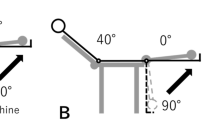Abstract
Rating of perceived exertion (RPE), or the Borg scale, has been shown to be positively associated with physiologic effort in individuals undergoing cardiovascular assessment. This study examined the correlations between cardiovascular performance, psychosocial factors, and the RPE scale among 50 persons with chronic pain undergoing multidisciplinary assessment. The results indicated a significant negative association between fitness outcome measures (maximum VO2 and endurance on bicycle), psychosocial measures, and age. With a mean maximum heart rate achieved on the exercise bicycle of 79.2% (SD = 8.3), there was no significant association between the highest rating of perceived exertion on the exercise bicycle test and percent of maximum heart rate. Percent of maximum heart rate was significantly related to self-reported pain and disability as well as age. These findings suggest that perceived exertion in this population is not highly correlated with physiologic effort, as other factors such as pain may influence effort ratings.
Similar content being viewed by others
REFERENCES
Borg G. Perceived exertion: A note on “history” and methods. Med Sci Sports 1973; 5: 90–93.
Mayer TG, Prescott JM, Gatchel RJ. Objective outcome evaluation: Methods and evidence. In: Mayer TG, Gatchel RJ, Polatin PB, eds. Occupational musculoskeletal disorders. Function, outcomes, and evidence. Philadelphia: Lippencott Williams and Wilkins, 2000, pp. 651–670.
Bonica JJ. Definitions and taxonomy of pain. In: Bonica JJ, ed. The management of pain, Vol. 1, 2nd edn. Philadelphia: Lea and Febiger, 1990, pp. 18–27.
Radloff L. The CES-D scale: A self-report depression scale for research in the general population. J Appl Psychol Meas 1977; 1: 385–401.
Turk DC, Okifuji A. Detecting depression in chronic pain patients: Adequacy of self-reports. Behav Res Ther 1997; 32: 9–16.
Melzack R. The McGill Pain Questionnaire: Major properties and scoring methods. Pain 1975; 1: 277–299.
Kopec JA, Esdaile JM, Abrahamowicz M, Abenhaim L, Wood-Dauphinee S, Lamping DL, Williams JI. The Quebec Back Pain Disability Scale: Conceptualization and development. J Clin Epidemiol 1996; 49(2): 151–161.
Clark ME, Kori SH, Brockel J. Kinesiophobia and chronic pain: Psychometric characteristics and factor analysis of the Tampa Scale. Am Pain Soc 1996; 15: 71–77.
Golding LA, Myers CR, Sinning WE. The Y's way to physical fitness. Champaign, IL: Human Kinetics Publishers, 1989.
American College of Sports Medicine. Guidelines for exercise testing and prescription, 5th edn. Philadelphia: Williams and Wilkins, 1995.
Borg G. Perceived exertion as an indicator of somatic stress. Scand J Rehab Med 1970; 2/3: 92–98.
Borg G, Domserius M, Kaijser L. Effect of alcohol on perceived exertion in relation to heart rate and blood lactate. Eur J Appl Physiol 1990; 60(5): 382–384.
Wittink H, Michel TH, Wagner A, Sukiennik A, Rogers W. Deconditioning in patients with chronic low back pain: Fact or fiction? Spine 2000; 25: 2221–2228.
Geisser ME, Haig AJ, Theisen ME. Activity avoidance and function in persons with chronic back pain. J Occup Rehab 2000; 10(3): 215–227.
Author information
Authors and Affiliations
Rights and permissions
About this article
Cite this article
Wallbom, A.S., Geisser, M.E., Haig, A.J. et al. Concordance Between Rating of Perceived Exertion and Function in Persons with Chronic, Disabling Back Pain. J Occup Rehabil 12, 93–98 (2002). https://doi.org/10.1023/A:1015060530414
Issue Date:
DOI: https://doi.org/10.1023/A:1015060530414




